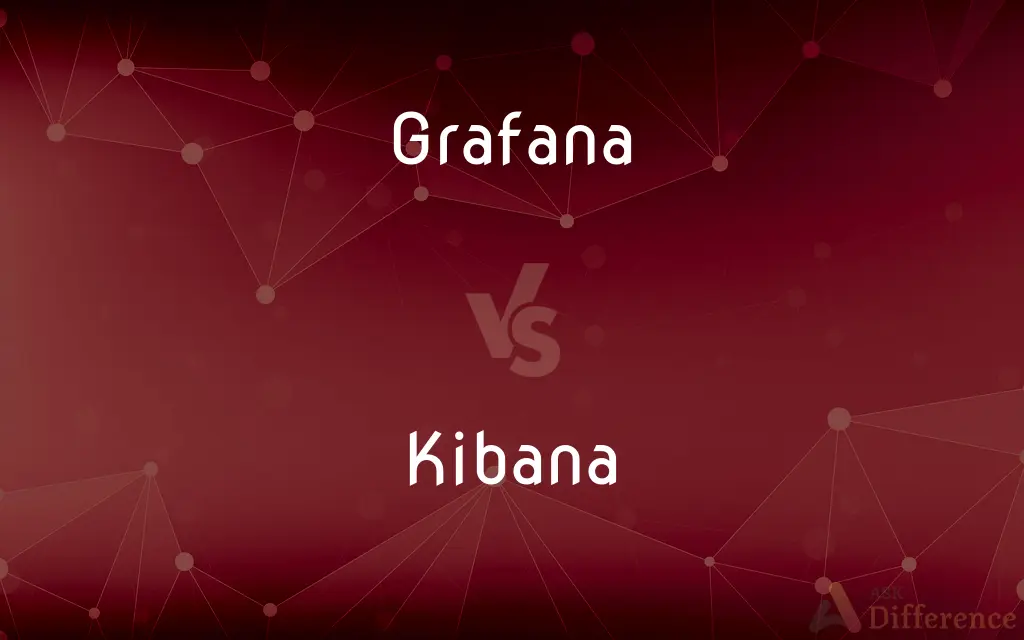Grafana vs. Kibana — What's the Difference?
By Fiza Rafique & Maham Liaqat — Updated on April 16, 2024
Grafana is multi-platform open-source analytics and interactive visualization web application providing charts, graphs, and alerts for web. Kibana is an open-source data visualization dashboard for Elasticsearch, offering views on log and time-series.

Difference Between Grafana and Kibana
Table of Contents
ADVERTISEMENT
Key Differences
Grafana is highly versatile, supporting a wide range of databases including Graphite, Prometheus, and Elasticsearch, enabling it to function across various environments and use cases. Conversely, Kibana is designed primarily for use with Elasticsearch, focusing on visualizations that make use of Elasticsearch's aggregations.
Grafana is celebrated for its highly customizable and extensive visualization tools, which include heatmaps, histograms, and complex dashboards that can be adjusted to suit nearly any operational need. On the other hand, Kibana specializes in providing out-of-the-box visualizations like pie charts, line graphs, and histograms tailored specifically for the data stored in Elasticsearch.
In terms of alerting capabilities, Grafana allows users to set up alerts on the metrics and log data directly from the dashboard, integrating with various notification channels. Whereas Kibana has historically lagged in this area, relying more on Elasticsearch's X-Pack for alerting features, which can be less intuitive than Grafana's built-in tools.
Grafana also offers better support for mixed data sources, enabling users to create dashboards that pull data from multiple sources simultaneously. This makes it ideal for complex operational environments where data is aggregated from various sources. Kibana, while improving in this respect with newer versions, still primarily focuses on visualizing data from Elasticsearch clusters.
Both tools are equipped with features for sharing dashboards and visualizations. Grafana dashboards can be easily shared and embedded in different applications. Kibana, while offering similar functionality, typically sees sharing within the confines of the Elastic Stack environment.
ADVERTISEMENT
Comparison Chart
Primary Data Source Compatibility
Multiple sources including Graphite, Prometheus, and Elasticsearch
Primarily Elasticsearch
Visualization Capabilities
Extensive customization options with support for a wide variety of charts
Strong integration with Elasticsearch, offering specialized visualizations
Alerting Features
Advanced alerting capabilities with support for multiple notification channels
Basic alerting available, enhanced through X-Pack
Data Source Integration
Supports mixed data sources in a single dashboard
Limited to data within the Elastic ecosystem, improving over time
Use Cases
Broad use across various data analysis applications
Primarily used for log data analysis and application monitoring within the Elastic Stack
Compare with Definitions
Grafana
A tool for creating dynamic dashboards from multiple data sources.
They used Grafana to monitor both machine metrics and application logs.
Kibana
Primarily used to analyze log data.
Their IT team used Kibana to pinpoint the cause of application failures logged in Elasticsearch.
Grafana
Known for its powerful alerting and visualization capabilities.
Grafana alerted them immediately when server performance degraded.
Kibana
Integrates tightly with other Elastic products for a cohesive experience.
They used Kibana alongside Logstash and Beats for comprehensive log analysis.
Grafana
Supports integration with a wide range of data sources.
Grafana's dashboard combined data from Prometheus and MySQL.
Kibana
Offers built-in visualizations tailored for time-series metrics.
Kibana's time-lapse feature visualized trends in application use over time.
Grafana
Often used in operational environments for real-time data monitoring.
The network operations center displayed several Grafana dashboards.
Kibana
A data visualization dashboard software for Elasticsearch.
Kibana helped them visualize Elasticsearch data across numerous indices.
Grafana
Allows for extensive customization of dashboards.
They customized their Grafana dashboard to include specific performance metrics critical to their application.
Kibana
Focuses on ease of use with out-of-the-box visualizations.
Kibana provided immediate visual insights into their data without extensive setup.
Grafana
Grafana is a multi-platform open source analytics and interactive visualization web application. It provides charts, graphs, and alerts for the web when connected to supported data sources.
Kibana
Kibana is a proprietary data visualization dashboard software for Elasticsearch, whose open source successor in OpenSearch is OpenSearch Dashboards.
Common Curiosities
Can Grafana use Elasticsearch as a data source?
Yes, Grafana can integrate with Elasticsearch, providing flexibility in how data is visualized and monitored.
Can Kibana visualize non-Elasticsearch data?
Kibana's primary focus is on Elasticsearch data, although newer features and plugins are expanding its capabilities.
How do both tools support sharing of dashboards?
Both Grafana and Kibana offer functionalities to share and embed dashboards, with Grafana providing more flexibility outside the Elastic Stack.
What are the key strengths of Grafana?
Grafana excels in customizable visualizations, alerting, and support for multiple data sources.
What makes Kibana unique?
Kibana's deep integration with Elasticsearch and its specialized visualizations for Elasticsearch data.
How do Grafana and Kibana handle alerts?
Grafana has built-in support for comprehensive alerting across various channels, while Kibana relies more on Elasticsearch’s X-Pack for alert functionality.
Is Kibana capable of real-time monitoring?
Yes, Kibana supports real-time monitoring, particularly effective with time-series data from Elasticsearch.
Which tool is better for mixed data source environments?
Grafana is typically better suited for environments that require integrating multiple data sources into a single dashboard.
What are the licensing costs for Grafana and Kibana?
Both Grafana and Kibana are open-source and free to use, with paid versions offering additional features and support.
Which tool is easier to set up and use for beginners?
Kibana might be easier for beginners, especially those already using Elasticsearch, due to its seamless integration and focused toolset.
Can these tools be customized?
Grafana offers more extensive customization options compared to Kibana, which is somewhat limited by its focus on Elasticsearch.
Which tool would you recommend for a startup?
Depending on the specific needs and existing data infrastructure, Grafana might be more adaptable for a startup needing to monitor a variety of data sources.
Do either Grafana or Kibana require special hosting?
Both can be hosted on-premise or used in cloud environments, depending on the user's infrastructure.
What are typical use cases for each tool?
Grafana is versatile across different scenarios from IT monitoring to marketing data analysis, while Kibana is best for log analysis and operational intelligence within Elastic environments.
How does community support compare between Grafana and Kibana?
Both have strong communities, with Grafana having a slightly broader range due to its support for multiple data sources.
Share Your Discovery

Previous Comparison
Also vs. Furthermore
Next Comparison
Fuzzle vs. MuzzleAuthor Spotlight
Written by
Fiza RafiqueFiza Rafique is a skilled content writer at AskDifference.com, where she meticulously refines and enhances written pieces. Drawing from her vast editorial expertise, Fiza ensures clarity, accuracy, and precision in every article. Passionate about language, she continually seeks to elevate the quality of content for readers worldwide.
Co-written by
Maham Liaqat














































